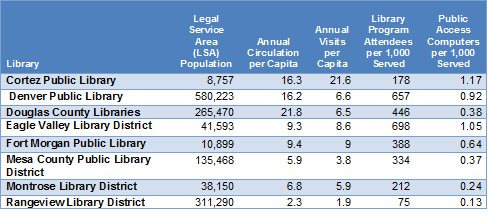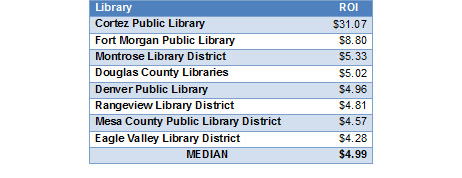It’s no secret that public libraries provide essential services to their patrons and are important resources for their communities. Intrinsic values are easy to understand, but actual values can be difficult to quantify. For every dollar spent on public libraries in Colorado, how much is returned to the community? Approximately $5, according to a study conducted by the Library Research Service (LRS).
The LRS report, Public Libraries – A Wise Investment: A Return on Investment Study of Colorado Libraries, details the results of a study utilizing a multiple case study approach to quantify the return on investment (ROI) to taxpayers for 8 public libraries in Colorado. These libraries represented geographically, economically, and demographically diverse regions of state, and included 3 large Front Range libraries (Denver Public Library, Douglas County Libraries, and Rangeview Library District); 3 in mountain communities (Montrose Library District, Eagle Valley Library District, and Cortez Public Library); 1 on the Western Slope (Mesa County Public Library District); and 1 on the Eastern Plains (Fort Morgan Public Library).
Usage patterns for these libraries varied as much as the libraries themselves (see Table 1.)
Table 1
Selected Characteristics of Public Libraries Used in Return on Investment Study, 2006 Note: Data is from the 2006 Public Library Annual Report, available at www.lrs.org.
Note: Data is from the 2006 Public Library Annual Report, available at www.lrs.org.
Assigning values
LRS utilized survey questionnaires filled out by almost 5,000 Colorado residents, a library survey, and existing data sources to determine how much – in dollars – libraries contribute to their communities. To identify library services or functions to which dollar values could be easily assigned, LRS looked at ROI studies completed in other states for guidance. Several different numbers were considered together in calculating final returns. These values included:
- “Cost to use alternatives” – Cost to patrons to acquire information or materials from an alternative source if the library did not exist
- “Lost use” – Direct benefit patrons who chose not to seek information elsewhere would lose if the library did not exist
- Local expenditures – What the library spends on goods and services in its community
- Lost staff compensation – Salaries and wages that would not be paid without the library
- “Halo spending” – Purchases made by patrons at businesses near the library when they visit
For more information on the methodology used in this study, see the full report at www.lrs.org/documents/closer_look/roi.pdf.
Results
For most of the libraries in the study, the ROI was approximately 5 to 1; for every dollar spent on the library, about 5 dollars of value was realized by taxpayers (see Table 2.)
Table 2
Return on Investment Per Dollar for Participating Libraries
Why so different?
As Table 2 illustrates, the ROI for the Cortez Public Library ($31.02 per $1.00) vastly exceeded the median, while the ROI for the Fort Morgan Public Library exceeded the median slightly ($8.80 per dollar). In these libraries, the discrepancy between who funds the libraries (municipalities) and who uses them (county residents) accounts for much of the difference in ROI. For a more detailed explanation, see the individual ROI reports for Cortez Public Library and Fort Morgan Public Library, available at www.lrs.org/public/roi.
Determining personal ROI
As part of this study, LRS created an interactive return on investment calculator that patrons of public libraries in Colorado can use to determine a personal return on their investment as taxpayers. The calculator (available at www.lrs.org/public/roi/usercalculator.php) assigns a dollar value to a single use of a particular library service. Individual returns on investment are based on the number of times the individual reports using each service per month and the typical annual tax contribution for the selected public library.
Using ROI
Return on investment studies can be valuable for public relations campaigns and budget discussions, as they detail how libraries benefit their communities in a dollars-and-cents way. While understanding the ROI value of libraries can be useful and important, it is equally important to remember that there are other dimensions of library value. True returns on taxpayer investments in public libraries include intangible benefits that are nearly impossible to quantify, such as the sense of community and lifelong learning that libraries help foster. It is important to keep asking patrons how they benefit and to communicate these values to patrons and stakeholders.
References
- Colorado Public Library Annual Report, 2007. (2007). Compiled by Library Research Service. Retrieved May 8, 2009, from www.lrs.org.
- Library Research Service. Individual Return on Investment Calculator. 18 April 2008. 8 May 2009 http://www.lrs.org/public/roi/usercalculator.php.
- Steffen, Nicolle, et al. Public Libraries – A Wise Investment: A Return on Investment Study of Colorado Libraries. (2009). Library Research Service. Retrieved May 8, 2009, from www.lrs.org.